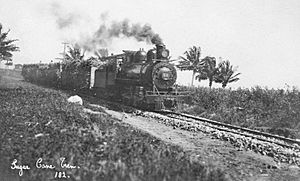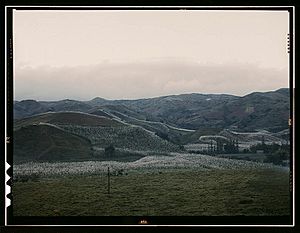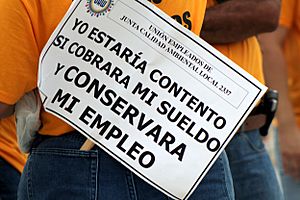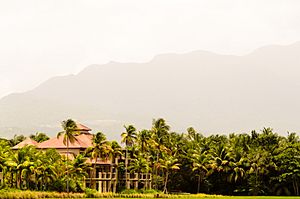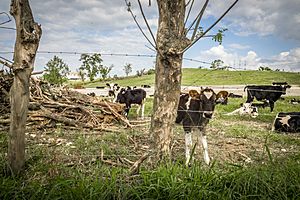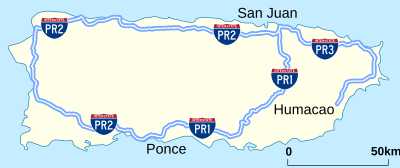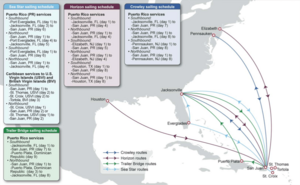Economy of Puerto Rico facts for kids
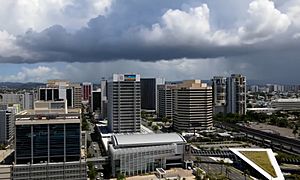
|
|
| Currency | United States dollar (US$) |
|---|---|
| 1 July – 30 June | |
|
Trade organizations
|
CARICOM (observer), IOC, ITUC, UNWTO (associate), hUPU |
| Statistics | |
| Population | |
| GDP |
|
| GDP rank | |
|
GDP growth
|
|
|
GDP per capita
|
|
|
GDP per capita rank
|
|
|
GDP by sector
|
|
| 1.0% (2020 est.) | |
|
Population below poverty line
|
N/A |
| 0.537 high (2010) | |
| 0.845 high (2015) (n/a rank) | |
|
Labor force
|
|
|
Labor force by occupation
|
|
| Unemployment | ▼ 7.7% (December 2018) |
|
Average gross salary
|
|
|
Main industries
|
Pharmaceuticals, electronics, apparel, food products, tourism |
|
Ease-of-doing-business rank
|
|
| External | |
| Exports | |
|
Export goods
|
Chemicals, electronics, rum, beverage concentrates, medical equipment, canned tuna, apparel |
|
Main export partners
|
|
| Imports | $43.32 billion CIF (2016 est.) |
|
Import goods
|
chemicals, machinery and equipment, food, petroleum products, clothing, fish |
|
Main import partners
|
|
|
Gross external debt
|
▲ $56.82 billion (31 December 2010, est.) |
| Public finances | |
|
Public debt
|
▲ 51.6% of GDP (2017 est.) |
|
Budget deficit
|
▼ $1.1 billion |
| Revenues | 9.268 billion (2017 est.) |
| Expenses | 9.974 billion (2017 est.) |
|
Credit rating
|
Standard & Poor's D |
The economy of Puerto Rico is considered a strong economy by the World Bank. It is also seen as the most competitive economy in Latin America. The main parts of Puerto Rico's economy are manufacturing, especially pharmaceuticals (medicines), textiles, and electronics. After manufacturing, the service industry is very important, including finance, insurance, real estate, and tourism.
Puerto Rico is an island, which affects its economy. It is a relatively small island and does not have many natural resources. This means it has to import many things. Its relationship with the United States also shapes its economy. The U.S. government controls Puerto Rico's foreign policies and has rules about shipping.
Puerto Rico has faced economic challenges since 2006. This was partly because a special tax rule for U.S. companies (Section 936) ended. This rule used to give tax breaks to U.S. companies in Puerto Rico. Even with these challenges, Puerto Rico has kept inflation low. Many of its economic problems come from old U.S. rules that no longer apply, and from its own government's past spending.
Compared to U.S. states, Puerto Rico has a lower income per person. About 45% of its people live below the poverty line. However, when compared to other places in Latin America, Puerto Rico has a higher income per person. The island also has a large debt, which means it owes a lot of money. In 2017, this debt was about $70 billion.
Puerto Rico has modern buildings and systems. It follows many rules from U.S. federal agencies. Its main trading partners are the United States, Ireland, and Japan. Many products come from East Asia, like China and South Korea. Because Puerto Rico relies on oil for transportation and electricity, and imports most of its food, its economy can be affected by changes in the world economy and climate.
Contents
Puerto Rico's Economic Journey
Puerto Rico's economy has changed a lot over time. It moved from being mostly about farming to being more about factories and technology.
Ancient Times
Before the Spanish arrived, the Taíno people lived in Puerto Rico. Their economy was a mix of hunting and gathering and farming. They caught small animals like lizards and birds. They also fished in nets.
The Taíno grew important crops like cassava (yuca) and sweet potatoes. They used special raised mounds of soil called conucos to grow these crops. They also grew corn, squash, beans, and pineapples.
Spanish Rule (1493-1898)
When the Spanish came in 1493, Puerto Rico's economy changed a lot. It relied on the forced labor of native people and later, enslaved people from Africa. These workers were made to work on farms and in mines.
Farming was the main way to produce goods. Crops like sugar cane, tobacco, and coffee were grown and sent to Europe. This was the main source of income for the island. Gold, silver, and copper were also mined, but not as much as in other Spanish territories.
Under U.S. Control (1898-Today)
In the early 1900s, sugar farming was the biggest part of Puerto Rico's economy. In 1935, U.S. President Franklin D. Roosevelt started a plan to help Puerto Rico's farms and build new public works.
Later, in the 1940s, a program called Operation Bootstrap began. This program offered tax breaks to factories that moved to Puerto Rico. Because of this, manufacturing became the main industry, replacing farming. This helped Puerto Rico become a "high income country." However, when the U.S. economy slowed down, Puerto Rico's economy often struggled too.
New trade agreements like NAFTA meant Puerto Rico lost some of its trade advantages. Also, U.S. minimum wage laws apply in Puerto Rico. This makes it harder for Puerto Rico to compete with countries where wages are lower. Some factories have moved to other countries because of this.
Many Puerto Ricans moved to the United States mainland, especially to New York City, looking for better jobs. This migration has continued over the years.
In 2006, the Puerto Rican government faced a money shortage. This led to schools and government offices closing for a short time. A new sales tax was put in place to help.
Puerto Rico's public debt grew quickly, reaching $46.7 billion in 2008. The government had to lay off many employees to save money. The unemployment rate also went up.
In 2010, Governor Fortuño suggested a tax reform plan to lower taxes for people and companies. Experts also noted that solving Puerto Rico's economic problems is linked to its political status.
Puerto Rico has been in an economic downturn since 2006. This was partly due to the end of Section 936, a tax break for U.S. companies. The government has also spent more money than it took in for many years, adding to its debt.
By 2017, the debt was about $70 billion. A special federal board was set up to help manage Puerto Rico's finances. Governor Ricardo Rosselló wanted Puerto Rico to become a U.S. state, hoping it would bring more federal money and benefits.
In September 2017, Hurricane Maria hit the island. This caused a lot of damage and led to many people leaving Puerto Rico. The population dropped by almost 12% by 2020. Efforts are now focused on renewable energy, technology, and helping new businesses start.
Economic Activities
Puerto Rico's economy is mainly driven by manufacturing and services.
Making Things (Manufacturing)
Manufacturing is the biggest part of Puerto Rico's economy, making up almost half of its total economic output. There are over 2,000 factories across the island. The Puerto Rico Industrial Development Company (PRIDCO) helps these companies with special benefits.
More than half of all manufacturing is in the pharmaceutical industry. This industry creates over 18,000 jobs and makes up a large part of the island's economy. Puerto Rico is one of the top places in the world for making medicines, with over 80 plants. Many big pharmaceutical companies have factories here.
Puerto Rico is also a major maker of biotechnology products and medical devices. These companies came to Puerto Rico because of tax benefits that have since ended. Even so, Puerto Rico still produces many of the top-selling medicines in the U.S.
The airplane parts industry is growing in Puerto Rico. Companies like Honeywell Aerospace and Lufthansa have operations there. Universities on the island help train engineers for these industries.
Services
The service industry is also very important. It includes finance, real estate, and tourism.
Money Matters (Finance)
The financial sector is a big part of Puerto Rico's economy. It works closely with the U.S. financial system and follows U.S. federal rules.
Homes and Land (Real Estate)
The real estate industry (buying, selling, and renting land and buildings) makes up a good portion of Puerto Rico's economy. It also provides many jobs.
Visiting the Island (Tourism)
Tourism brings in about $1.8 billion each year. Many tourists, mostly from the U.S., visit the island. Cruise ship passengers make up a big part of these visitors. New hotels and the Puerto Rico Convention Center show that tourism is strong.
Popular tourist spots include the Camuy River Cave Park, El Yunque National Forest, and Old San Juan. Gambling, mainly in casinos attached to hotels, also helps the economy.
Buying and Selling (Trade)
Because Puerto Rico is a U.S. territory, trade between Puerto Rico and the U.S. mainland is not subject to international border checks. However, all goods going to the U.S. mainland are checked for agricultural items.
Puerto Rico can collect import taxes only if it taxes the same goods made on the island. Puerto Rico is part of trade agreements that the United States signs. It can also join some international groups with U.S. permission.
Other Important Areas
New Ideas (Quaternary Sector)
Starting new businesses and doing research and development (R&D) are becoming more important. Companies like Neolpharma do a lot of R&D in Puerto Rico. Many groups support new businesses and research on the island.
Expert Advice (Quinary Sector)
Big management consulting companies like Accenture and Deloitte have offices in Puerto Rico. They help businesses and organizations with expert advice.
Key Economic Numbers
Here are some important numbers about Puerto Rico's economy:
- Debt: About $70 billion (as of January 2017).
- GDP (Gross Domestic Product): This is the total value of goods and services produced.
* Around $118.7 billion (2022 estimate). * Per person: About $38,440 (2022 estimate).
- Inflation Rate: How fast prices are rising, around 1.0% (2020 estimate).
- Industries: Medicines, electronics, clothing, food, tourism.
- Exports: Goods sent out, like chemicals, electronics, rum, and medical equipment. About $73.2 billion (2017 estimate).
- Imports: Goods brought in, like chemicals, machinery, food, and oil products. About $43.3 billion (2016 estimate).
- Sales Tax: 11.5% (7% for prepared food).
- Labor Force: About 1.1 million people (2019).
How Puerto Rico Works
Puerto Rico has modern systems and follows U.S. federal rules. It is treated much like a U.S. state in many ways.
Learning and Schools (Education)
Education is free for low-income families from preschool through high school. There are many public schools, and some special magnet schools are very good. There are also many private schools, mostly Catholic.
Puerto Rico has many colleges and universities. The University of Puerto Rico (UPR) is the largest and most important. It does most of the research and graduates many engineers. However, the university system can be affected by politics.
Power, Water, and Services
Puerto Rico has to import all its fuel because it has no oil or natural gas. The Puerto Rico Electric Power Authority (PREPA) makes most of the electricity using fossil fuels. This means electricity is expensive in Puerto Rico, costing more than double the U.S. average. This high cost affects businesses and people's daily lives.
The Puerto Rico Aqueducts and Sewers Authority (PRASA) manages all the water supply. Drinking water comes from rain, lakes, and rivers, and is treated to be safe.
Staying Healthy (Healthcare)
Puerto Rico has a strong and modern healthcare system. It follows U.S. health rules. There are many doctors' offices, clinics, and hospitals, including special hospitals for heart disease, cancer, and children. There are also several medical schools that train doctors.
Mail and Shipping
The United States Postal Service has offices across the island. Companies like FedEx and UPS also operate there. Shipping goods to and from the U.S. is expensive because of a law called the Jones Act. This law requires that only U.S.-flagged ships can carry goods between U.S. ports, including Puerto Rico. This adds to costs for consumers.
Safety and Security
Local safety is handled by the Puerto Rico Police. Federal agencies like the FBI also work on the island for federal crimes. Fire protection and emergency medical services are also provided. Puerto Rico is part of the 9-1-1 emergency system. The Puerto Rico National Guard is the local military force.
Talking and Connecting (Telecommunications)
Telecommunications follow U.S. rules. There are many radio and television stations, and internet access is common. Companies offer internet, TV, and phone services. High-speed internet and mobile phones are widely available.
Getting Around (Transportation)
Puerto Rico has a good system of roads and highways. The capital, San Juan, has a public bus system and a train. Ferries connect the islands, and shared taxis are also used.
There are three international airports, with Luis Muñoz Marín International Airport being the largest in the Caribbean. Puerto Rico also has nine ports, with the San Juan Port being the busiest.
What Makes Puerto Rico Unique?
Puerto Rico doesn't have many special advantages in global markets because of its high business costs. However, it does have some advantages within the U.S. system. For example, lower wages and certain legal rules can benefit companies.
Companies might set up branches in Puerto Rico to use tax rules that apply only there. This can help them save money on taxes. But this also means that it's hard for Puerto Rico to compete with other countries where things are cheaper to make.
Government Money
Currency
Puerto Rico uses the United States dollar as its money. This means it doesn't control its own money supply or interest rates. It follows the U.S. financial policies.
Public Debt

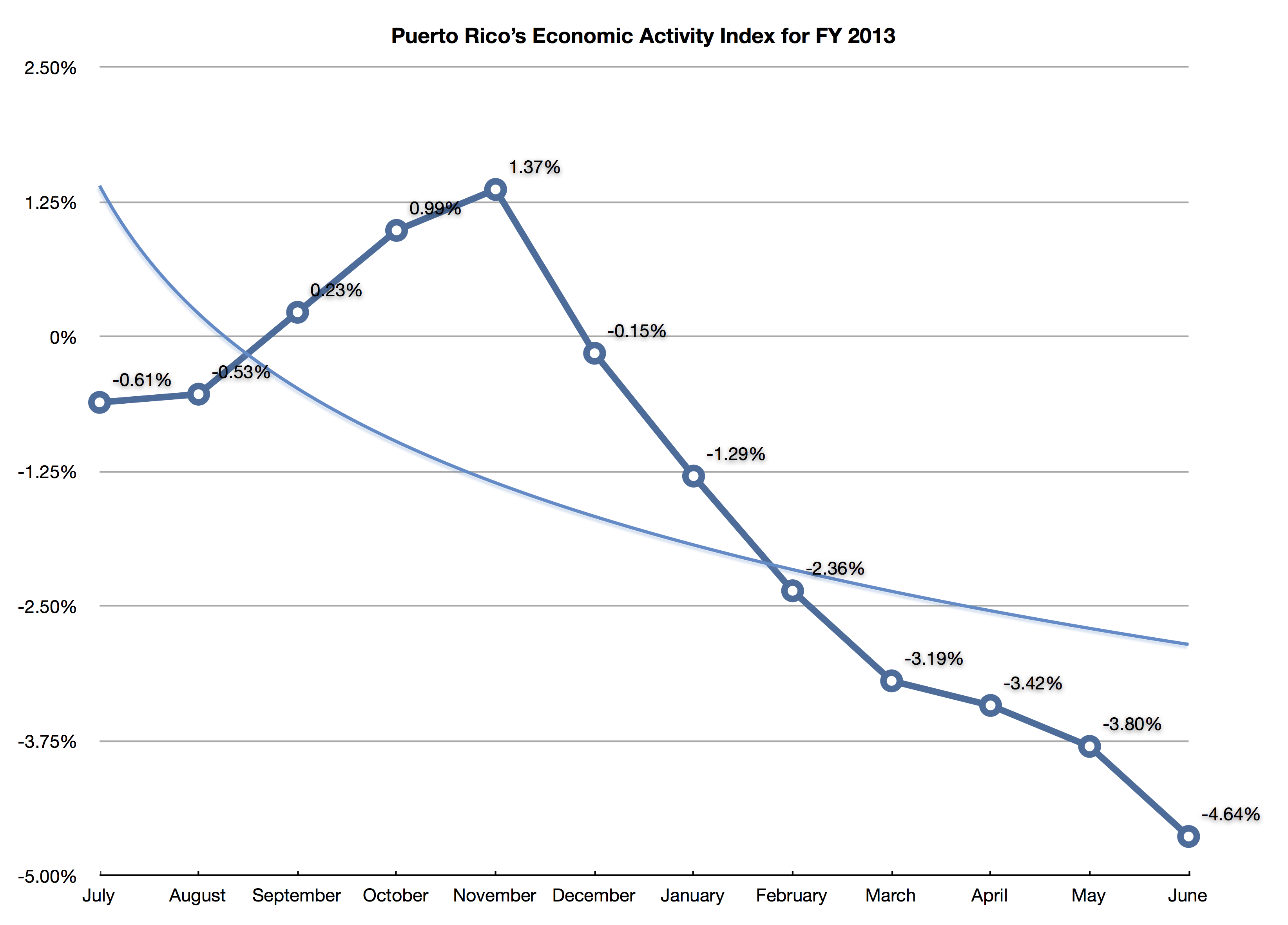 Puerto Rico's public debt has grown faster than its economy. In 2008, it reached $46.7 billion. Since 2000, the government has spent more money than it took in, leading to more debt.
Puerto Rico's public debt has grown faster than its economy. In 2008, it reached $46.7 billion. Since 2000, the government has spent more money than it took in, leading to more debt.
In 2014, Puerto Rico's debt was rated as "junk status," meaning it was very risky. By 2017, the debt was about $70 billion. The government has been working to make deals with those it owes money to.
Taxes
Puerto Rico has a complicated tax system. There are many different taxes and also many tax breaks. For example, people who move to Puerto Rico can get special tax benefits. In 2006, a 5.5% sales tax was put in place.
Comparing Puerto Rico
Business Sizes
Most businesses in Puerto Rico are small, with fewer than 250 employees. Many are very small, with fewer than 10 employees. However, larger companies still make up a significant part of the total payroll.
Cost of Living
The cost of living in San Juan, Puerto Rico, is quite high, similar to major U.S. cities like Miami. Housing prices can be high, but property taxes are lower than in many U.S. states. Shipping costs can also be higher.
Ease of Doing Business
The World Bank ranks Puerto Rico as the 40th easiest economy to do business in globally. It's easier to get credit and protect investors, but harder to get building permits.
Income Levels
In 2009, the average household income in Puerto Rico was $18,314. This is lower than the poorest U.S. state. However, Puerto Rico's income per person is one of the highest in the Caribbean. Federal payments to Puerto Rico also make up a big part of people's income.
In 2017, the average income was $25,332.
Workforce
Puerto Rico has a skilled workforce. Many workers are bilingual (speak two languages). They often cost less to hire than workers on the U.S. mainland, which is an advantage for U.S. companies.
Challenges for Puerto Rico
High Business Costs
The Jones Act makes shipping goods to and from Puerto Rico very expensive. This law means only U.S. ships can carry cargo between U.S. ports. This makes goods more costly for people in Puerto Rico. The local government has asked the U.S. Congress to change this law, but it hasn't happened.
Puerto Rico also has complex labor laws that add to business costs.
Government Inefficiency
The government has sometimes made choices that cost the island more in the long run. For example, even though Puerto Rico has many rivers, it doesn't use much hydroelectric power. Instead, it relies on expensive fossil fuels for electricity.
Puerto Rico imports most of its food, even though it has fertile land. This is due to a focus on other industries and a lack of farmers. Similarly, most wood is imported, even though local soil could support a lumber industry.
The public education system also faces challenges, with many students not finishing high school or performing at basic levels in tests. The government has also struggled with collecting taxes and managing its finances efficiently.
Population Decline

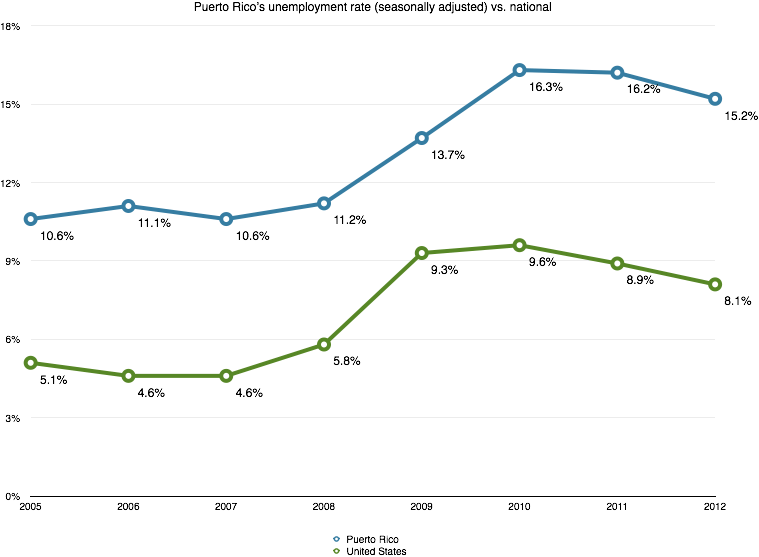
 Puerto Rico's population has been shrinking since 2000. Many people have moved to the U.S. mainland looking for better opportunities. This means fewer people are working and paying taxes, which creates more problems for the economy and government.
Puerto Rico's population has been shrinking since 2000. Many people have moved to the U.S. mainland looking for better opportunities. This means fewer people are working and paying taxes, which creates more problems for the economy and government.
Relationship with the U.S.
As a U.S. territory, Puerto Rico has limits on how it can interact with other countries. It must follow U.S. laws and trade agreements.
Unemployment
Unemployment is a big problem in Puerto Rico. The unemployment rate is often much higher than the U.S. national average. In 2017, it was still in double digits, and the poverty rate was very high.
Images for kids
See also
 In Spanish: Economía de Puerto Rico para niños
In Spanish: Economía de Puerto Rico para niños



